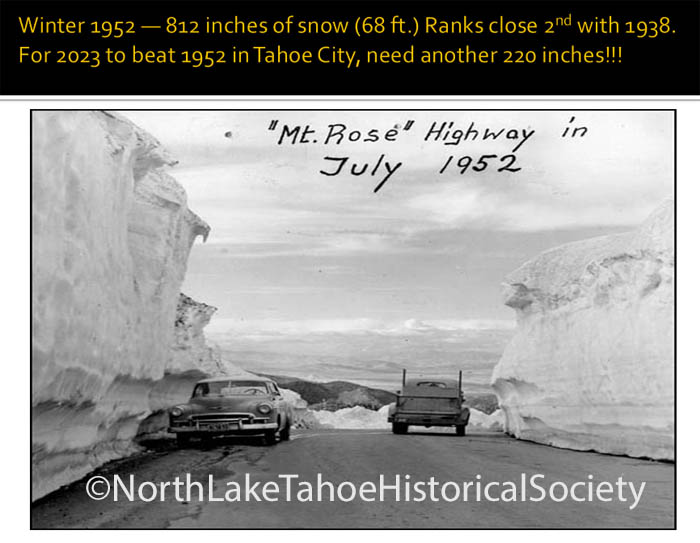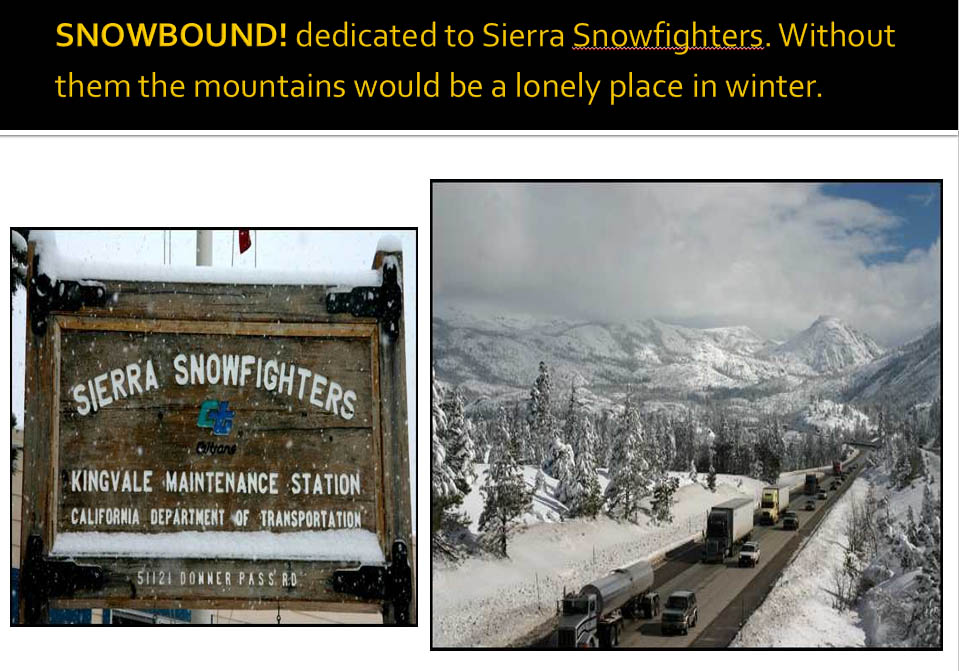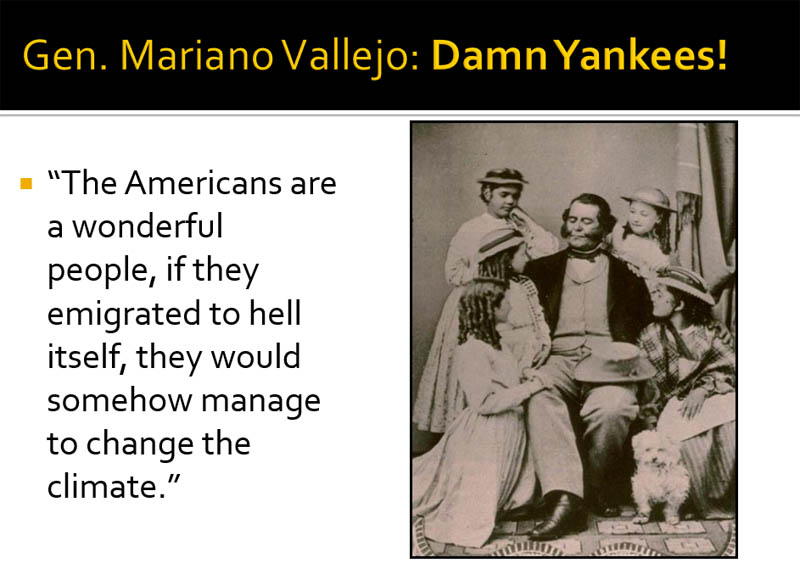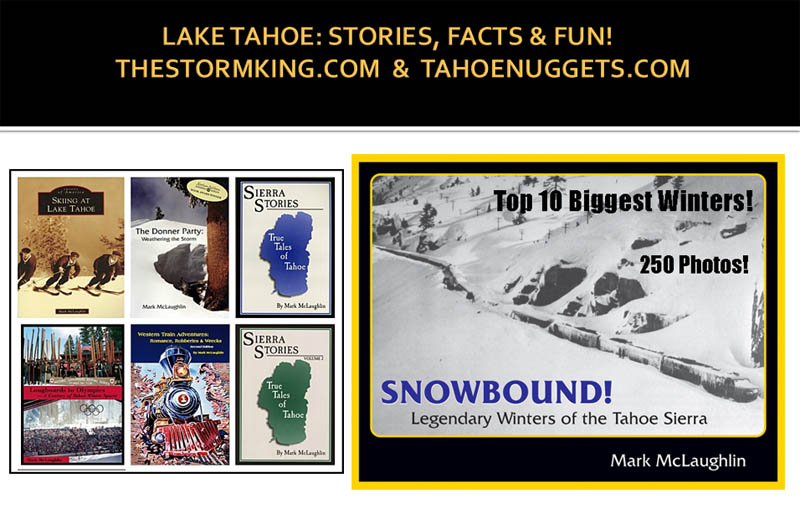Now that the snow has settled from the monster winter of 2023, it’s time that we dismiss the sensational headlines and understand that it was not the record season for snow and water in the Tahoe Sierra that the media would have you believe. References to “record snow/precipitation” continue even though data indicate otherwise.
That’s not to say it wasn’t an epic season in California. Officially, 2023 ranks 5th for snowfall at Central Sierra Snow Laboratory near Donner Pass (since 1880), and 5th for snow and 3rd for cold at Tahoe City where weather bureau measurements began in 1909, the longest dataset in the Tahoe Basin.
NOAA does not use snowfall data from ski areas in its official tallies, but in the Sierra high country incessant atmospheric rivers coupled with consistent below normal temperatures in 2023 translated into seemingly endless powder dumps.
A few California ski resorts set new maximum snowfall records for their locations, including Palisades Tahoe (Squaw Valley) with 723 inches at 8,000 feet elevation. Mammoth Mountain in the southern Sierra blew past its old record with 885 inches (74 feet). Mammoth is still open with top to bottom skiing so get out there if you still need more runs in your quiver.
In the Great Basin, at least 8 Utah resorts set new maximum snowfall totals. Alta Ski Area set a record with 903 inches (75 feet) by the time it closed at the end of April 2023. The region is famous for its light fluffy snow, but for those who got a taste of the bottomless “cold smoke powder” this winter will be bragging about for years to come. Utah hydrologists tallied 30 inches of snow water equivalent (SWE) in the snowpack statewide, also a record.
In April 2023 I created a Power Point presentation for a client that briefly analyzes last winter’s impact in the Tahoe Sierra and its historical ranking for snow and precipitation. (Precipitation is the combination of rain and water equivalent of snow.) I extracted about 10 slides to illustrate this Tahoe Nugget.





The Northern Sierra is the most important region in California for water storage captured from runoff draining the normally wet watershed north of Highway 50 to Mount Shasta. The Northern Sierra 8-Station Index was established in 1922 to provide hydrologists with vital, real-time data regarding precipitation values throughout this vast region. Note that the precipitation value for 2023 is well shy of the top water years.

Tahoe City’s 316 inches (26.3 ft.) of snowfall in 2023 was good enough for 5th place, but needs another 220 inches ((18.3 ft.) to overtake the 1st place winter of 1952! Check out the July 1952 snowpack below.


I’ve used this slide for years. General Mariano Vallejo was an important Californio and ally of the United States in the Mexican American War (1846-48). Despite the fact that the Americans arrested and confined him to prison for no good reason. Vallejo is not talking about climate change in the modern sense, he’s commending the Americans for their industry and can-do spirit.


Follow Mark McLaughlin on Facebook
Read my bi-weekly column in Tahoe Weekly magazine.
17 replies on “#292: Winter 2023: Facts, not Hyperbole”
Thanks Mark – Wonderful!
Geologically speaking, we still have a very small and limited sampling of data. Dov the native American tribes indigenous to the basin areas have any “tall” tales from their ancestors?
Hi Vince. I think that the real problem is that the click-bait-oriented media drowns out science and perspective. I expect it will only get worse.
Great stuff! You are the Storm King!
Going back to our History Channel “Snowbound” documentary from the early aughts…
Wasn’t 1952 the year the Chicago-to-Oakland train became trapped in Donner Pass?
Yes Mike, the train entrapment occurred in January 1952.
Hi Mark
This is your old friend from Zephyr Cove, really enjoyed your analysis of the Tahoe winters. It was a bit easier in Palm Springs this winter, only rained out from golf three times! Hope to see you soon.
Tom
Hi Tom. Great to hear from you my old friend. Are you in Tahoe with Bonnie this summer?
Is there any data on how much snow might have fallen in the Donner Pass are in the winter of 1846-47, when the Donner Party tragedy took place. Possibly, could ships logs from Monterey Bay be analyzed for rainfall data?
Also, were there any records kept for the Soda Springs area and Donner Pass for the winter of 1866-67, when 44 major storms impacted that area?
Greatly enjoyed your analysis of this past winter in the Tahoe area. It’s impact on me has been the fact I can’t even get a quote for doing some roof work!!!
Hi Paul. Great to hear from you. I analyzed the American warship logs from San Francisco Bay and Monterey during the Mexican American War during the winter of 1847, but there is no way to extrapolate how that rainfall translated into snow in the mountains. My book The Donner Party: Weathering the Storm is the most comprehensive overview of the weather during that winter but it relies on eyewitness observations by rescuers, survivors and the diary of Patrick Breen.
The snowfall amounts for CSSL should really be updated with totals for the entire season. They ended up with 753″, so 4th overall and only 66″ behind first place…not record breaking but quite impressive.
Hi Jack. I suspected that there was some additional snowfall from those scattered late spring snow showers. I’ll be circling back with CSSL manager Andrew Schwartz to confirm that latest tally. In fact, the water year ends on Sept. 30 so there is the possibility of adding a bit more to the total in September. I’ve seen significant cold storms in September in years past.
Climate will always change. Humans leave garbage but only slightly change the climate with co2, which at the moment is at the minimum. Co2 has been 3 times higher than current levels and humans didn’t do anything.
Hi Dave. I will agree and disagree. Climate change is real but contributes only a percentage to the troubling environmental conditions we find ourselves in. We can blame modern humans for centuries of mismanagement of forests, oceans, landscape, atmosphere, etc. Humans today are self-centered, ignorant, consumptive and divorced from the ecological natural balance that Indigenous Peoples embraced for millennia. Sad state of affairs.
Great article Mark. So awesome to be reading your fresh work again.
Big hugs,
Jamie & Larry
Of course I always love you guys! I’m sure that the ADVENTURE continues. Wish you safe travels and beautiful sunsets.
Super interesting, as always. Thanks! Love that quote from General Vallejo. Sad but true…